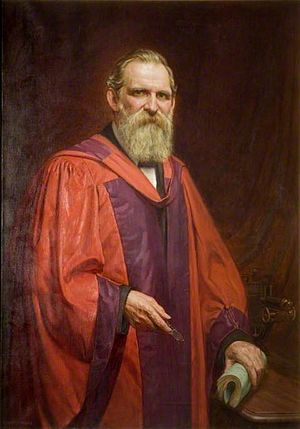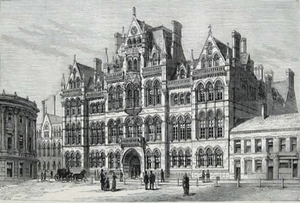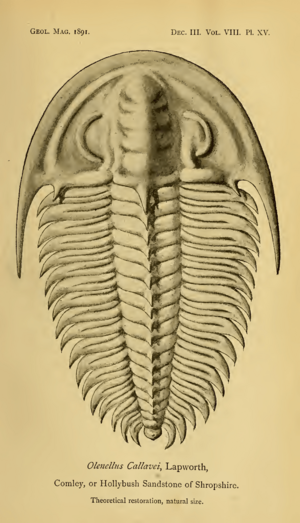Charles Lapworth facts for kids
Quick facts for kids
Charles Lapworth
|
|
|---|---|
 |
|
| Born | 20 September 1842 |
| Died | 13 March 1920 (aged 77) Birmingham, England
|
| Awards | Bigsby Medal (1887) Royal Medal (1891) Wollaston Medal (1899) |
Charles Lapworth (born September 20, 1842 – died March 13, 1920) was an English geologist and teacher. He made big discoveries about how to use index fossils to understand rock layers. He also named a whole new time period in Earth's history, called the Ordovician period. He was a very important scientist who helped us learn more about our planet's past.
Contents
Charles Lapworth's Early Life and Teaching Career
Charles Lapworth was born in Faringdon, England. He trained to be a teacher at Culham Diocesan Training College. After finishing his training, he moved to Scotland.
From 1864 to 1875, he was the headmaster of a school in Galashiels. While teaching, he also spent a lot of time exploring the rocks and fossils in the Scottish border region. In 1869, he married Janet Sanderson.
How He Solved a Rock Mystery
Lapworth used his skills to map out the rocks in the area. He looked closely at index fossils, which are special fossils that only appear in rocks from certain time periods. By studying these fossils, especially at a place called Dob's Linn, he figured out something amazing.
Scientists used to think there was a very thick layer of Silurian rocks. But Lapworth showed that these rocks were actually much thinner. They just looked thick because they had been folded and broken by faults over millions of years. It was like a stack of papers that got crumpled up and looked thicker than it really was.
He did all this important research while still working as a schoolmaster! In 1875, he became an assistant at Madras College in St Andrews, Scotland. Then, in 1881, he became the first professor of geology at Mason Science College in Birmingham, England. This college later became the University of Birmingham. He taught there until he retired in 1913.
Discovering the Ordovician Period
Charles Lapworth is most famous for his work with index fossils, especially tiny sea creatures called graptolites. He used them to study the Silurian rock layers.
Naming a New Time in Earth's History
He noticed that some rock layers were stuck between the very old Cambrian rocks and the Silurian rocks. These layers had their own unique fossils. Lapworth suggested that these rocks belonged to a brand new geological time period. He called it the Ordovician period, named after an ancient Welsh tribe called the Ordovices.
This idea helped solve a big argument among geologists called the "Highlands Controversy." Two famous geologists, Roderick Murchison and Adam Sedgwick, couldn't agree on the age of these rock layers. Lapworth's idea helped everyone understand the true order of Earth's history.
Lapworth also did important work in the English Midlands. He found fossils of ancient creatures called Olenelloid trilobites in Shropshire. These fossils showed that very old Cambrian rocks were hidden beneath younger rocks. He even suggested that some rocks in Scotland, like the Torridonian sandstone, were even older than the Cambrian period. Later, other geologists, Peach and Horne, confirmed his ideas.
Charles Lapworth passed away on March 13, 1920, and was buried in Lodge Hill Cemetery near Birmingham.
Lapworth's Family Life
Charles Lapworth and his wife, Janet Sanderson, had five children. Sadly, their first and last children died when they were very young. Their other three children, Arthur, Herbert, and Edith Matilda, grew up. Arthur Lapworth became a famous chemist, and Herbert became an engineer and also studied geology and fossils.
Awards and Recognition
Charles Lapworth received many awards for his important work in geology.
- In 1888, he became a Fellow of the Royal Society, a very respected group of scientists.
- In 1891, he won the Royal Medal.
- In 1899, he received the Wollaston Medal, the highest award from the Geological Society of London.
- He was also elected President of the Geological Society from 1902 to 1904.
A glacial lake, Lake Lapworth, was named after him because he was the first to suggest it existed in 1898. He also received honorary degrees from Aberdeen University and Glasgow University. In 1916, he was made an Honorary Fellow of the Royal Society of Edinburgh.
Lapworth Museum of Geology
If you want to learn more about Charles Lapworth, you can visit the Lapworth Museum of Geology at the University of Birmingham. The museum has many of his papers and research notes. It's a great place to see how he worked and what he discovered!
Images for kids





